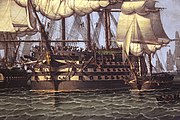HMS Queen Charlotte (1810)
 Detail of Robert Salmon's The British Fleet Forming a Line off Algiers
| |
| History | |
|---|---|
| Name | HMS Queen Charlotte |
| Ordered | 9 July 1801 |
| Builder | Deptford Dockyard |
| Laid down | October 1805 |
| Launched | 17 July 1810[1] |
| Commissioned | January 1813 |
| Fate | Sold, 12 January 1892 |
| General characteristics [2] | |
| Class and type | 104-gun first-rate ship of the line |
| Tons burthen | 2289 bm |
| Length | 190 ft 0+1⁄2 in (57.9 m) (gundeck) |
| Beam | 52 ft 5+3⁄4 in (16.0 m) |
| Depth of hold | 22 ft 4 in (6.8 m) |
| Propulsion | Sails |
| Sail plan | Full rigged ship |
| Armament |
|
HMS Queen Charlotte was a 104-gun first-rate ship of the line of the Royal Navy, launched on 17 July 1810 at Deptford. She replaced the first Queen Charlotte sunk in 1800.
Career
She was Lord Exmouth's flagship during the Bombardment of Algiers in 1816.
On 17 September 1817, Linnet, a tender to Queen Charlotte, seized a smuggled cargo of tobacco. The officers and crew of Queen Charlotte shared in the prize money.[Note 1]
On 17 December 1823, Queen Charlotte was driven into the British ship Brothers at Portsmouth, Hampshire, England.[4] Brothers suffered severe damage in the collision.[4]
-
Council of war on board Queen Charlotte, 1818, by Nicolaas Baur
-
Detail of Robert Salmon's The British Fleet Forming a Line off Algiers
Fate
Queen Charlotte was converted to serve as a training ship in 1859 and renamed HMS Excellent. She was eventually sold out of the service to be broken up in 1892.[2]
Notes, citations, and references
Notes
Citations
- ^ The Times (London), Wednesday, 18 July 1810, p.3
- ^ a b Lavery, Ships of the Line vol.1, p187.
- ^ "No. 17360". The London Gazette. 16 May 1818. p. 892.
- ^ a b "The Marine List". Lloyd's List (5865). 19 December 1823.
References
- Lavery, Brian (2003): The Ship of the Line - Volume 1: The development of the battlefleet 1650-1850. Conway Maritime Press. ISBN 0-85177-252-8.
- Winfield, Rif (2008): British Warships in the Age of Sail: 1793 - 1817. Seaforth Publishing. ISBN 978-1-84415-717-4.
External links
 Media related to HMS Queen Charlotte (ship, 1810) at Wikimedia Commons
Media related to HMS Queen Charlotte (ship, 1810) at Wikimedia Commons


